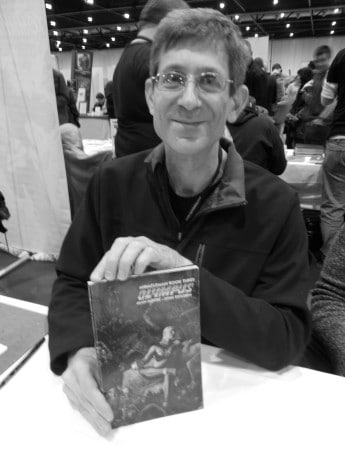Written for the screen and directed by Roman Polanski
France, 2013
What is art if not an artist’s fiction translated into reality? A fiction wrought from fear, self-loathing and prejudice that escapes the confines of a sonnet and burrows its way into the collective consciousness. Now it is reality. Now it has power. Now it’s an idea, and ideas are poisonous. Rather than dispelling the poisonous reality, Polanski’s Venus in Fur toys with the delicate fiction lying beneath. It’s a study in role-playing, where the players and creators are equally baffled by the game. More importantly, this is the intensely personal work of an artist who understands that only by blurring the lines between fiction and reality can he approach what Herzog calls, “the ecstatic truth.”
To call Venus in Fur a ‘play-within-a-play’ is a misnomer. Indeed, it involves the inner workings of a stage play, but it’s not concerned with the minutiae of performance art or commenting on the theatrical establishment. The play is merely a pretense for the artist, in this case, writer-director, Roman Polanski, to deconstruct his personal version of reality.
The first hint of this intention comes staggering into a cavernous Paris theater in the form of Polanski’s own wife, Emmanuelle Seigner. She’s soaked and disheveled from a thunderstorm, her ample cleavage barely contained beneath a shoddy coat. It’s a lurid fantasy made flesh; the desperate actress willing to do anything to land the role. In this case, that means impressing the play’s writer-director, Thomas (Mathieu Amalric). Polanski quickly subverts this fantasy, however, by making Vanda (Seigner) a complicated character. Yes, she is a ditzy seductress in turns, but she’s also intelligent and capable. In one subtle scene she expertly adjusts the stage lighting before callously sticky her chewing gum beneath the control panel. She’s a confident woman who isn’t afraid to challenge the director’s artistic vision. In short, she’s a fantasy woman who refuses to conform to the fantasy.
Further inviting speculation about the personal nature of Polanski’s film are Amalric’s appearance and mannerisms. Like many of Woody Allen’s recent pictures, the lead actor is a thinly-veiled surrogate for the director. Amalric’s performance as Thomas—with hunched posture and nervous countenance—has Polanski’s fingerprints all over it. Thomas has the brittle ego of an artist and the expansive passion of a poet. In other words, he’s a raw nerve; willing to explore the dark corners of his text but quick to lash out against perceived trespasses.
Working from the award-winning play by David Ives (which was based upon Leopold von Sacher-Masoch’s novella), Polanski has no interest in absolutes. As the audition progresses and Vanda delves deeper into her role, Thomas is confronted by an actress who understands the conflicted reality behind his fictional creation. She dismisses her character as the sexist, misogynist creation of an emotionally-stunted mind. Thomas counters that his play is about passion; that which can’t be reduced to a social construct or fodder for special interest groups. Of course, both of them are right, which is precisely Polanski’s point.
Polanski’s playful direction winks at the audience without ever becoming too heavy-handed. For instance, the actors only pantomime their stage directions but we still hear the resultant sound effects from their actions; an invisible cup of coffee clatters on the plate in Thomas’ trembling hand, or Vanda unfolds a crinkled (invisible) paper nestled firmly against her breast. Polanski also makes clever use of his set design. A phallic cactus looms in the background like an actor waiting for his big scene. And when that scene finally arrives… it is grand, indeed. Emotional speeches are interrupted by cheesy ringtones and grand artistic gestures are stifled by crass non-sequiturs. It’s all the work of a director who wants us to take the material seriously without becoming too serious. Venus in Fur is a provocation rather than a proclamation.
The amazing performances of Amalric and Seigner complement Polanski’s terrific script, which requires frequent and abrupt changes of emotional direction. As the lines between fiction and reality blur, the actors shift seamlessly from characters on a printed page to wounded people using those characters to explore their inner demons. Indeed, they are so good at this transformation that it becomes impossible to separate the character from the performer. In one particularly fascinating scene, Vanda transforms herself from a seductress sprawled across a sofa to an inquisitive psychologist prodding her reluctant patient. Likewise, Thomas transforms from a defiant protagonist to a defensive patient being psychoanalyzed on his doctor’s sofa. The brilliance and subtlety of this scene works not only on a narrative level, but also harkens back to the intimate nature of Polanski’s project. This is an artist who is literally analyzing himself before our very eyes.
What exactly Polanski discovers probably depends upon what you bring into Venus in Fur. Your reality will inform the fiction on the screen, just as that fiction fashions a new version of reality. Polanski melds narrative and theme to perfectly capture this process of artistic engagement. At one point in the film, Thomas muses that, “Life makes us what we are in an unpredictable moment.” Perhaps our interpretation of that moment is even more important than the moment itself. In trying to discern fiction from reality, we create our own version of the truth. Blurring those lines is a worthwhile endeavor, especially when it’s this entertaining.







